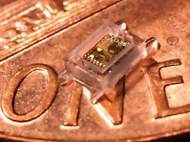Millimeter scale computing systems could be used to monitor eye pressure
 Nearly invisible millimeter-scale systems could enable computing to be used nearly in everything around us, and the researchers from the University of Michigan (U-M) claim that’s the future of the industry. They point to Bell’s Law, which says there’s a new class of smaller, cheaper computers about every decade. They plan to use their miniature system as an implantable eye pressure monitor for glaucoma.
Nearly invisible millimeter-scale systems could enable computing to be used nearly in everything around us, and the researchers from the University of Michigan (U-M) claim that’s the future of the industry. They point to Bell’s Law, which says there’s a new class of smaller, cheaper computers about every decade. They plan to use their miniature system as an implantable eye pressure monitor for glaucoma.
“When you get smaller than hand-held devices, you turn to these monitoring devices”, said David Blaauw, professor at the U-M Department of Electrical Engineering and Computer Science. “The next big challenge is to achieve millimeter-scale systems, which have a host of new applications for monitoring our bodies, our environment and our buildings. Because they’re so small, you could manufacture hundreds of thousands on one wafer. There could be 10s to 100s of them per person and it’s this per capita increase that fuels the semiconductor industry’s growth.”
Blaauw and his colleague Professor Dennis Sylvester target their new system toward medical applications. In a package that’s just over 1 cubic millimeter, the system fits an ultra low-power microprocessor, a pressure sensor, memory, a thin-film battery, a solar cell and a wireless radio with an antenna that can transmit data to an external reader device that would be held near the eye in order to track the progress of glaucoma, a potentially blinding disease.
“This is the first true millimeter-scale complete computing system”, said Sylvester. “Our work is unique in the sense that we’re thinking about complete systems in which all the components are low-power and fit on the chip. We can collect data, store it and transmit it. The applications for systems of this size are endless.”
The processor in the eye pressure monitor is the third generation of the researchers’ Phoenix chip, which uses a unique power gating architecture and an extreme sleep mode to achieve ultra-low power consumption. The newest system wakes every 15 minutes to take measurements and consumes an average of 5.3 nanowatts. To keep the battery charged, it requires exposure to 10 hours of indoor light each day or 1.5 hours of sunlight. It can store up to a week’s worth of information.
While this system is miniscule and complete, its radio doesn’t equip it to talk to other devices like it. That’s an important feature for any system targeted toward wireless sensor networks.
Assistant professor David Wentzloff and doctoral student Kuo-Ken Huang have developed a consolidated radio with an on-chip antenna that doesn’t need the bulky external crystal usually used when two isolated devices need to transfer information to each other. By integrating the antenna through an advanced CMOS process, they can precisely control its shape and size and therefore how it oscillates in response to electrical signals. This approach significantly shrinks the radio system, making it less than 1 cubic millimeter in size.
“Antennas have a natural resonant frequency for electrical signals that is defined by their geometry, much like a pure audio tone on a tuning fork”, said Wentzloff. “By designing a circuit to monitor the signal on the antenna and measure how close it is to the antenna’s natural resonance, we can lock the transmitted signal to the antenna’s resonant frequency. This is the first integrated antenna that also serves as its own reference. The radio on our chip doesn’t need external tuning. Once you deploy a network of these, they’ll automatically align at the same frequency.”
They are working on lowering the radio’s power consumption so that it’s compatible with millimeter-scale batteries. The university is pursuing patent protection for the intellectual property, and they’re seeking commercialization partners to help them bring the technology to the market. The researchers expect that the device will be commercially available within several years.









author
The researchers are collaborating with Ken Wise, the William Gould Dow Distinguished University Professor of Electrical Engineering and Computer Science on the packaging of the sensor, and with Paul Lichter, chair of the Department of Ophthalmology and Visual Sciences at the U-M Medical School, for the implantation studies.